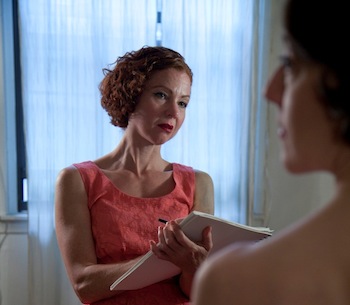A Harrowing and Brilliant Look at Gay America in 1958
June and Nancy
New York Fringe Festival
Kraine Theater
85 E. Fourth Street
New York, N.Y.

It's 1958, and gays and lesbians live “a life in hiding.” Nancy is a lesbian who met June, a woman married for ten years, at an art museum, where she worked as a volunteer guide. June has had two miscarriages and is in a frustrating marriage to a man who only sees her as the woman who provides meals, housecleaning, occasional sex and nothing more. She has no love and no future and has started to hit the bottle. Nancy, for her part, is out of work, has no partner and is thinking about moving to San Francisco.
The two women fall in love and tumble into a lonely, sad and harrowing “life in hiding” as lesbians in a world where women in general are hopelessly repressed by society, much less lesbian women. The meeting of the two women kicks off one of the most brilliant plays in New York in years, June and Nancy, by Michelle Ramoni, who also stars as June. It's a landmark, groundbreaking play that takes a strained and hurtful look at U.S. social history. It is a story that reminds us of what tremendous strides gay Americans have made since 1958. Today there are national parades for gay rights, openly gay congressional representatives (and now openly gay generals!), gay couples can marry in some states and many routinely adopt children. The closet and the "life in hiding" are increasingly becoming things of the past.
But not in 1958. June, a fledgling artist whose works don’t seem to attract any buyers, has no idea how to love a woman and bumbles her way through the start of her affair with middle-aged Nancy, a concerned, caring life-long lesbian who is all alone in the world. Nancy, a lithographer, fully understands discrimination against lesbians and women. At the start of the play, she delivers a talk at a lithographers’ convention but nobody pays any attention because she is a woman.
June falls for Nancy, the play suggests, because she does not get the love and support she needs at home from her husband, Marty, a happy, back-slapping type of guy, who, like most men of his era, believed in subservient roles for women. He has no idea that his wife has started an affair, let alone with a woman.
Nancy, who tells June that she is a straight woman who happened to fall for a woman, and that she is not a lesbian, genuinely loves June and does not know how she can win her away from her husband in an era in which that simply did not take place.
Their story takes several turns, some good and some bad. Some people do find out about them. June does try to patch things up with her husband and he with her. Nancy, in the end, has to decide whether to stay with June or move on with her life. The play rumbles to a shattering and heart-wrenching climax.
The real beauty of June and Nancy is the masterful interplay between the two actresses, Michelle Ramoni (June) and Gabrielle Maisels (Nancy). They are wonderfully tender and intimate with each other. They take the affair ever so slowly and just let it happen, worrying about the consequences later. It is a warm love story, even though it is a tale with chilling repercussions.
The history of the play is sketched briefly but graphically. Nancy reminds June again and again that gay people have no rights and must hide from the general population. They associate with lesbians only at private parties. They are always looking over each other’s shoulder, never hold hands in public, and avoid public displays of affection. The audience is reminded that gays were loathed in 1958 in a world that did not understand them and wanted to sweep them under the rug, or out the door.
Director Kate Holland has done fine work in bringing out all of the tenderness out of Ramoni’s script and building up the roles of the men, as well as the women, in the show. She gets truly memorable performances from the two women and superb ones from Jeff Coyne as the oafish but lovable Marty and Peter Daniel Straus as the very funny male museum guide who is just biting through his lip as he tries to figure out what is going on between June and Nancy.
This is a solid love story, tinged with sadness, that reminds you how difficult life was for gay Americans in the 1950s. It was a time when strides were starting to be made everywhere for all minorities, except them. The brief nudity in the show seems natural and is not gratuitous; it is directly connected to the plot.
June and Nancy is not just a theatrical triumph, but a triumph of American culture.
PRODUCTION: Produced by the New York Fringe Festival and Stage Left Studio. Lighting: Daisy Long; Sound: Chris Chappell and Justin Cornell; Costumes: Renee Erikson. The play was directed by Kate Holland.
